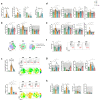A Short Corticosteroid Course Reduces Symptoms and Immunological Alterations Underlying Long-COVID
- PMID: 34829769
- PMCID: PMC8614904
- DOI: 10.3390/biomedicines9111540
A Short Corticosteroid Course Reduces Symptoms and Immunological Alterations Underlying Long-COVID
Abstract
Despite the growing number of patients with persistent symptoms after acute SARS-CoV-2 infection, the pathophysiology underlying long-COVID is not yet well characterized, and there is no established therapy. We performed a deep immune profiling in nine patients with persistent symptoms (PSP), before and after a 4-day prednisone course, and five post-COVID-19 patients without persistent symptoms (NSP). PSP showed a perturbed distribution of circulating mononuclear cell populations. Symptoms in PSP were accompanied by a pro-inflammatory phenotype characterized by increased conventional dendritic cells and augmented expression of antigen presentation, co-stimulation, migration, and activation markers in monocytes. The adaptive immunity compartment in PSP showed a Th1-predominance, decreased naïve and regulatory T cells, and augmentation of the PD-1 exhaustion marker. These immune alterations reverted after the corticosteroid treatment and were maintained during the 4-month follow-up, and their normalization correlated with clinical amelioration. The current work highlights an immunopathogenic basis together with a possible role for steroids in the treatment for long-COVID.
Keywords: corticosteroids; immunological alterations; long-COVID.
Conflict of interest statement
The authors declare no conflict of interest.
Figures


References
Grants and funding
LinkOut - more resources
Full Text Sources
Miscellaneous

